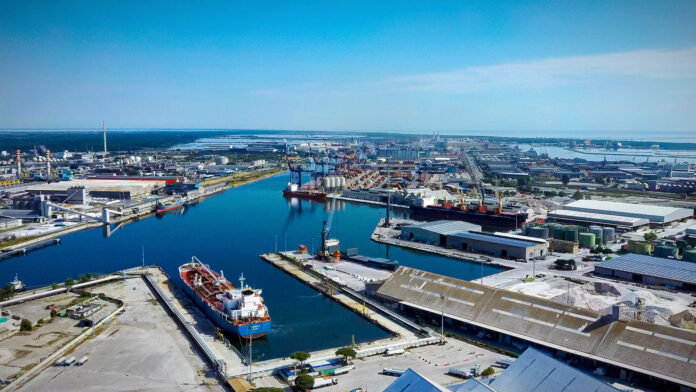New private 5G infrastructure to enable smart port applications like anti-collision systems, autonomous vehicles, drones for cargo monitoring, and real-time traffic analysis.
Private 5G – newly-formed Fastweb+Vodafone will deliver a private 5G network for the Port of Ravenna, covering shipyards, terminals, and 15km of canal-way back to the city.
IoT monitoring – new edge setup enables tracking and control of port traffic, safety and comms, environmental factors, fuel consumption, energy usage, autonomous vehicles.
Port evolution – port authority is pumping €10m into new digital tech to meet European directives on maritime sustainability and safety, as well as to drive its own economic growth.
The North-Central Adriatic Sea Port System Authority, responsible for port operations and commercial and industrial activities at the Port of Ravenna in Italy, has appointed Fastweb+Vodafone to build a private 5G network across the port area, as well as along 15 kilometres of canal connecting the port to the City of Ravenna, in the Emilia-Romagna in northern Italy. Lepida, the local state-owned system integration company, is part of the delivery team, as well.
The Port of Ravenna hosts shipyards, multipurpose terminals, bulk cargo terminals, and a containerized cargo terminal. There are also a big passenger and cruise line terminal, plus the biggest marinas of the Adriatic Sea. The brief to Fastweb+Vodafone, created after Swisscom’s €8 billion acquisition of Vodafone Italia in January (and integration with its local Fastweb fixed-line business), is to deliver a high performing, highly performant secure private cellular edge setup to support advanced industrial IoT cases, as well as worker comms.
There is no word on the network vendors for the project. Vodafone, Fastweb, and Swisscom all work variously with Nokia, Ericsson, Cisco, and Athonet/HPE for the supply of private networks. A statement said the new private 5G network will support various port applications, including: video surveillance, vehicle tracking, and license plate recognition at entry gates (crossed with ‘trucking data’); anti-collision systems between vehicles and people; drones for “dangerous” cargo monitoring and out-of-reach traffic analysis; and management of autonomous vehicles.
The project is expected to enhance cybersecurity around data transmissions, as well as safety and operational efficiency, said a statement. The port will deploy a Push to Talk platform to allow orders, images, and audio to be sent to groups deployed on docks, warehouses, or transport vehicles – to improve coordination between control-room and field staff. The reference is to “hundreds of IoT devices”, initially – to monitor traffic and port activity, equipment and machinery, and environmental conditions.
The Port of Ravenna, ranked first in Italy for handling dry bulk and general cargo (and “one of the first” to implement a private 5G in the country), has a stated ‘smart port model’ to improve logistics, safety, and environmental sustainability. It is investing over €10 million in new digital technology to meet new European directives on maritime sustainability and safety. The new 5G network will support the integration of renewable energy systems near the port, including solar/photovoltaic and wind power, and enable live monitoring of vehicle fuel consumption.
It will also support ‘cold ironing’, allowing ships to switch off their engines and connect to the port’s electrical supply. A statement (in translation) said of the cold-ironing setup: “Not all ports are equipped to provide this service, and the technology transition requires facilities, infrastructure, and an advanced digital management system. Private 5G [is] the must-have pivot to securely and reliably manage the huge flow of data needed to coordinate the new electrical distribution facilities, with clear benefits in terms of pollution reduction.”
The port will collect environmental data about salinity and pollution levels. The new setup will be developed for “self-driving vehicles for container transport and AI algorithms to prevent accidents through IoT sensors and video analysis” – notably, in the latter case, for the safe management of overhead cranes and gantries. The new setup will integrate with existing fiber infrastructure, or else operate device-to-cloud, as required and permitted.
Vodafone said (in translation): “The goal is not only to make ship transit more efficient, but also to introduce a new paradigm of digital transformation in the port area, where collaboration between digital technologies and human operators can redefine operations and processes. In addition to the private network, Vodafone business is to provide an ecosystem of digital solutions ranging from smart video surveillance to IoT platforms for vehicle tracking, environmental parameter detection and remote management of overhead cranes or self-driving vehicles.”
Angelo Mazzotti, head of digital and environmental sustainability at the Ravenna Port Authority, said: “The project is still in the early stages, but the solutions implemented and the technology offered so far show the high potential to further raise the safety and operational efficiency of the port of call. We are confident that as activities continue, this push for real digitization and technological innovation will contribute significantly to the development and modernization of the port, complementing the many infrastructure investments that have been made in recent years.”

